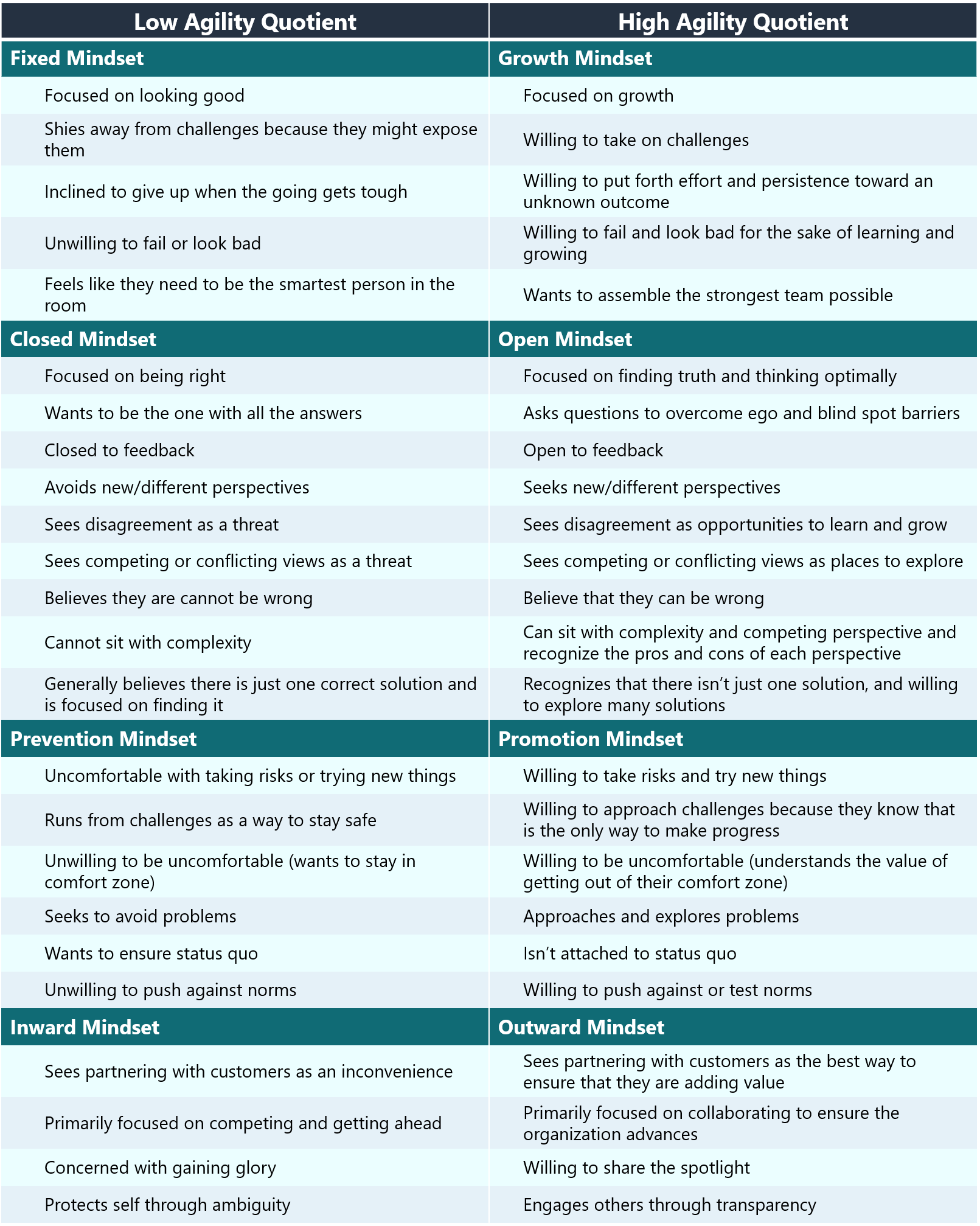(Cover image credit: Ryderwear – https://www.ryderwear.com/collections/womens-leggings/)
You have heard of intelligence quotient (IQ) and emotional intelligence (EQ), but have you heard of agility quotient (AQ).
Ok, so agility quotient hasn’t been rigorously studied like IQ or EQ, but that doesn’t mean it doesn’t have important practical implications.
Agility quotient is one’s ability or capacity to swiftly adapt to the changing needs of customers, employees, and the marketplace.
Why is it Needed?
The rate of change is faster than ever. Disruption of organizations and industries is increasingly occurring.
In fact, there are three rapidly increasing phenomena that all organizations are facing:
- Increasing competition
- Decreasing or compressed product life cycles
- Rapidly changing customer interests and needs
Together, this means that if organizations want to stay viable in the long run, they have to have the ability to adapt and pivot. And, in order for that to happen, organizations need employees that have the ability to quickly adapt and pivot: a high agility quotient.
Low versus High Agility Quotient
What sets apart someone with high agility quotient from someone with a low agility quotient?
At a basic level, someone with low AQ is someone who values certainty, consistency, and comfort. Often, the reason why individuals might possess such values is that they are focused on what is best for them, creating a sense of safety and security for themselves.
Someone with high AQ is someone who values learning, alternative perspectives, and personal disruption. Often, the reason why individuals might possess these values is that they are more concerned about (1) providing what is best for the customer, and (2) doing what is best for the long-term success for the organization, over and above a concern of what is best for themselves.
Microsoft Example
I think a great example of an organization that has helped employees make a significant positive shift in their agility quotient is Microsoft.
When Satya Nadella took over as CEO, he found that Microsoft employees needed to be the smartest people in the room, which meant a lot of jockeying for power and position and an inability to be wrong and see different perspectives. They were more focused on doing what was best for them than they were focused on doing what was best for their customers and the organization as a whole.
As Satya Nadella set out to work on cultural change within Microsoft to become more agile, he promoted the idea that instead of being “know-it-alls,” they needed to become “learn-it-alls.”

And, to promote this shift, he encouraged employees to meet more and more with their customers at their customer’s locations. They were to identify what needs they had and ways in which their products were falling short of what they needed.
A natural byproduct of this is that Microsoft employees were coming back from meeting with their employees having learned something new, seeing a new perspective, and a willingness to disrupt themselves and what they were doing in order to better meet the needs and demands of their customers.
The result of this has been a four-fold in market capitalization and stock price since Satya Nadella took over in 2004.
Improving Agility Quotient in Your Organization
How do you take employees from having a low agility quotient to having a high agility quotient? At a foundational level, we have got to recognize that the difference between such individuals isn’t a difference in skill or ability, it is a difference in how they see and perceive their world around them. It is a difference in their mindsets.
Consider the following table that demonstrates this related to the four mindset sets that I focus on:

This suggests that if you want to improve your employees’ and your organization’s agility quotient, you’ve got to focus on helping them develop growth, open, promotion, and outward mindsets.
What is Your Agility Quotient?
If you want to get a sense of what your agility quotient is, take my FREE 20-question personal mindset assessment, which will provide you with an individualized and comprehensive report on your mindsets and will allow you to see which side of the table you are on associated with each of the different sets of mindsets
What is Your Organization’s Agility Quotient?
If you want to see the degree to which your organization has the mindsets necessary for agility, I can work with you to assess that and produce a collective mindset report that will quickly indicate the degree to which your leaders and employees have the mindsets necessary for agility.
How to Improve Your Agility Quotient?
You can learn all about how to improve your mindsets and therefore your agility quotient in my new book, Success Mindsets.











